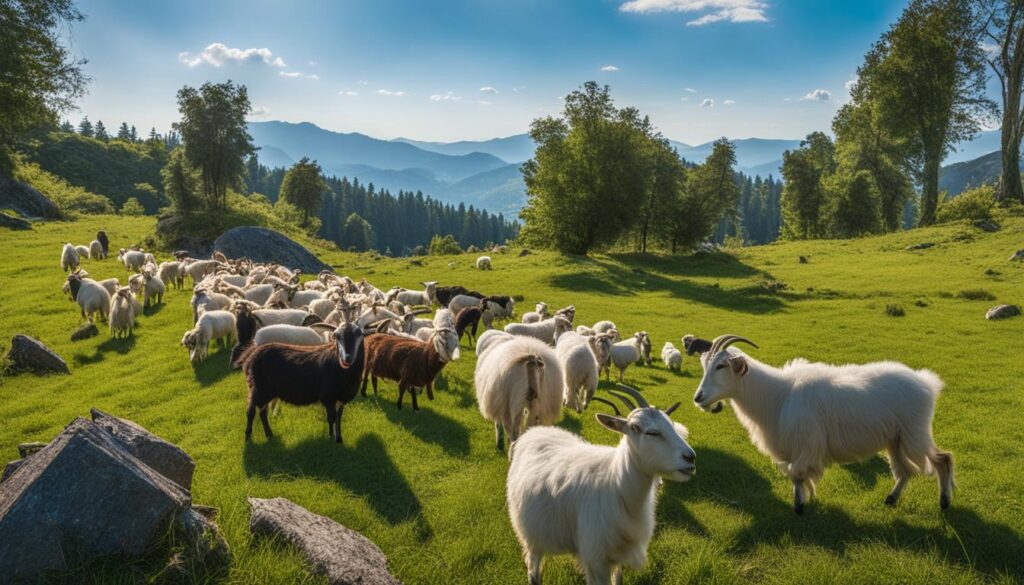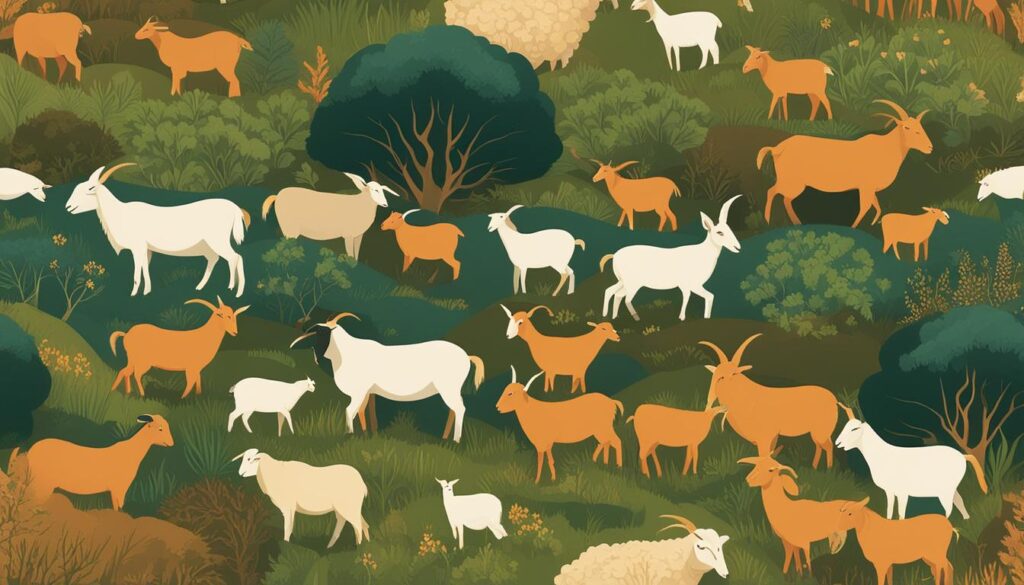As a hobby farmer, my journey in integrating goats and sheep grazing into my pasture management system has revolutionized not only my approach to livestock production but the overall health and productivity of my land. These animals aren’t merely inhabitants of the farm; they’re key players in maintaining a vibrant hobby farming ecosystem. By employing their unique grazing behaviors, I’ve been able to combat the gradual encroachment of woody plants that once threatened the diverse grassland habitat vital for my sheep grazing forage. Pasture management isn’t just a practice—it’s an art that blends the natural benefits of grazing animals with the soil and plants they feed on, creating a harmonious balance that powers all life on the farm.
Utilizing the natural tendencies of goats and sheep to browse and graze respectively, I’ve seen first-hand how this symbiotic relationship fosters not only the creatures in my care but also the very ground beneath our feet, enhancing biodiversity and reducing over-utilization of forage species. This shift has made all the difference, ensuring that even in lean seasons, my pasture remains a lush source of nutrition for the herd and a place of serene beauty for me.
Key Takeaways
- Integrating goats and sheep effectively enhances pasture management.
- Dual-species grazing benefits the hobby farming ecosystem by promoting biodiversity.
- Sustainable sheep grazing relies on forage diversity maintained by multi-species grazing.
- Goats and sheep grazing benefits include improved forage production and weed control.
- Proactive pasture management supports livestock health and productivity.
- Grazing strategies need to be adapted to maintain balance during variable climate conditions.
The Nature and Benefits of Targeted Grazing
As I delve into the intricacies of pasture management, the strategic application of targeted grazing completely shifts the paradigm from conventional grazing methods. Distinct from the traditional approach, where the focus is on animal production, targeted grazing harnesses the natural behavior of livestock as a tool for achieving specific land management goals. In my years of practice, it has proven not just beneficial, but essential in biodiversity reinforcement and invasive species control.
Defining Targeted Grazing in Pasture Management
The definition of targeted grazing revolves around using livestock to manipulate plant communities in a way that meets specific objectives. Each species of livestock plays a unique role, acting as a brush cutter, lawn mower, or fertilizer spreader based on their feeding habits. Leaning into this concept transforms my animals into active agents in the ecosystem, helping me to direct their foraging energy toward areas that require intervention such as overgrown brush or weed infestations.
The Unmatched Advantages of Multi-Species Grazing
The introduction of multi-species grazing into my land stewardship practices has been a revelation. The efficiency of multi-species grazing shines when different types of livestock graze in concert; their varied dietary needs and grazing patterns mesh together to cover a wider range of vegetation than any single species could manage alone. Here’s why this symbiotic relationship between goats, sheep, and cattle enhances pasture health and overall productivity:
- Goats: They target woody plants and weeds with gusto, helping to clear out unwanted overgrowth and making room for more desirable forage species.
- Sheep: Their preference for forbs and certain grasses complements the goats’ feeding, promoting a more balanced forage ecosystem.
- Cattle: With their grass-centric diet, cattle fill in the grazing gaps, maintaining the grasslands that are essential for a healthy pasture.
In adopting these methods, I’ve witnessed the profound impact of using livestock not just for their production value, but as a versatile and effective grazing tool. It’s an approach that has redefined my relationship with my land, turning everyday grazing into a targeted effort to cultivate a more resilient and diverse ecosystem.
Understanding Goats and Sheep Grazing Dynamics
Grazing behaviors are not solely a matter of routine for livestock; they encapsulate a complex interaction with the surrounding environment that affects the very fabric of forage diet composition. When I survey my pastures and observe the grazing livestock adaption to the resources available, it’s clear that each species contributes uniquely to the health of the ecosystem. Goats often amble towards the shrubby areas, their eyes set on the woody plants, an integral part of their diets. As a hobby farmer, I’ve learned to respect and integrate these natural tendencies into my land management strategies.

Sheep, with a more reserved approach to browsing, exhibit a preference for the soft textures of forbs and grasses that carpet much of the pasturelands. They complement the goats, creating a symbiotic relationship where each species utilizes different plant types, thus fostering a diverse forage diet composition. This selective dining, which seems almost intentional, has significant benefits, reducing competition and promoting a balanced forage use across the different terrains of my farm.
Indeed, the adaptability of these animals to various landscapes is fascinating. Where you’ll find goats traversing steeper inclines with ease, sheep are more content grazing the gentle slopes and flatlands. This natural division of land preferences aids in preventing overgrazing in one area, a testament to the remarkable resilience and adaptability inherent in grazing livestock. As they adapt, they inadvertently shape the land in ways conducive to a broader ecological balance.
As any seasoned hobby farmer would know, these behaviors are not by chance but the result of centuries of adaption. Today, they give us a powerful tool for natural and efficient pasture management. Below is an overview of the grazing behaviors and forage preferences of goats and sheep:
| Livestock Type | Forage Preference | Percentage of Browse in Diet | Preferred Terrain |
|---|---|---|---|
| Goats | Woody plants, shrubs | 43% | Steep, rocky areas |
| Sheep | Forbs, grasses | 22% | Gentle slopes, flatlands |
Witnessing the harmony between these grazing strategies reinforces my commitment to maintaining a multi-species approach to grazing. It underscores the beauty of a well-tuned forage diet composition that is only possible with a keen understanding of grazing livestock adaption.
Principles of Multi-Species Grazing for Land Restoration
As I’ve walked my fields over the years, the truth of land restoration through multi-species grazing has unfolded before my eyes. This practice rests on embracing the natural synergy between different types of grazing animals, particularly goats and sheep. Each species contributes uniquely to the ecological function of pastures, performing roles that, when combined, lead to a diverse, resilient grazing system.

The Synergy of Goats and Sheep in Grazing Systems
Within my grazing system, goats are the maestros of managing invasive woody plants, effectively reducing brush overgrowth. Sheep complement this perfectly by focusing their appetites on the forbs and grasses, filling gaps in the land’s diet that goats might leave behind. This creates a heterogeneous landscape, where not just the variety of plants increases, but the wildlife that those plants support thrives as well.
Long-Term Ecological Benefits and Biodiversity Enhancement
The enhancement of biodiversity is a gradual but striking benefit of this method. In my commitment to nurturing multi-species grazing, I have watched as once sparse patches now teem with life, offering a greater variety of forage to my livestock. This diversity extends below ground, too, with soil health markedly improved, indicating a clear rise in the overall ecological function of my land. As the biodiversity within my pastures grew, the parasitic load on my animals decreased, exemplifying the subtle yet profound impact of this grazing system. The symbiosis between goat and sheep grazing has truly been a keystone in my journey of ecological stewardship.
Implementing Goats and Sheep Grazing Rotations for Maximum Yield
As a proponent of subsistence homesteading, I’ve learned that effective pasture management is pivotal for sustaining an environment in which my goats and sheep can thrive. To enhance pasture yield, I’ve embraced the concept of grazing rotations, a practice that demands a good deal of strategy but rewards with ample returns. This involves meticulous grazing rotation planning, which begins by evaluating the forage production and carrying capacity of my land. It’s this understanding that allows me to set stocking rates which assure I don’t overburden the pasture, both ensuring the well-being of my herds and preserving the long-term fertility of the soil.
The rhythm of moving animals from paddock to paddock isn’t arbitrary but is inspired by the wisdom of agrarian experts like Andre Voisin. Through planned rotations, my animals enjoy a varied diet of fresh forage, which in turn, leads to greater health and productivity. This cyclical pattern is not just about feeding livestock; it allows each section of pasture adequate recovery time, which is crucial for maintaining a high pasture yield and vigorous regrowth. With intentional design, I’ve observed improved ground cover and soil structure, which are essential elements in any successful grazing ecosystem.
Ultimately, the essence of grazing rotations is harnessing the natural behaviors of goats and sheep to create a sustainable framework for land management. By executing a well-devised plan, I’m continually seeing benefits like reduced feed costs, improved animal health, and higher quality forage. This translates to a healthier bottom line for my homestead, ensuring not just survival, but prosperity. It’s a grounded, rewarding approach to animal husbandry and land stewardship that enlightens every step I take on my pastoral journey.

